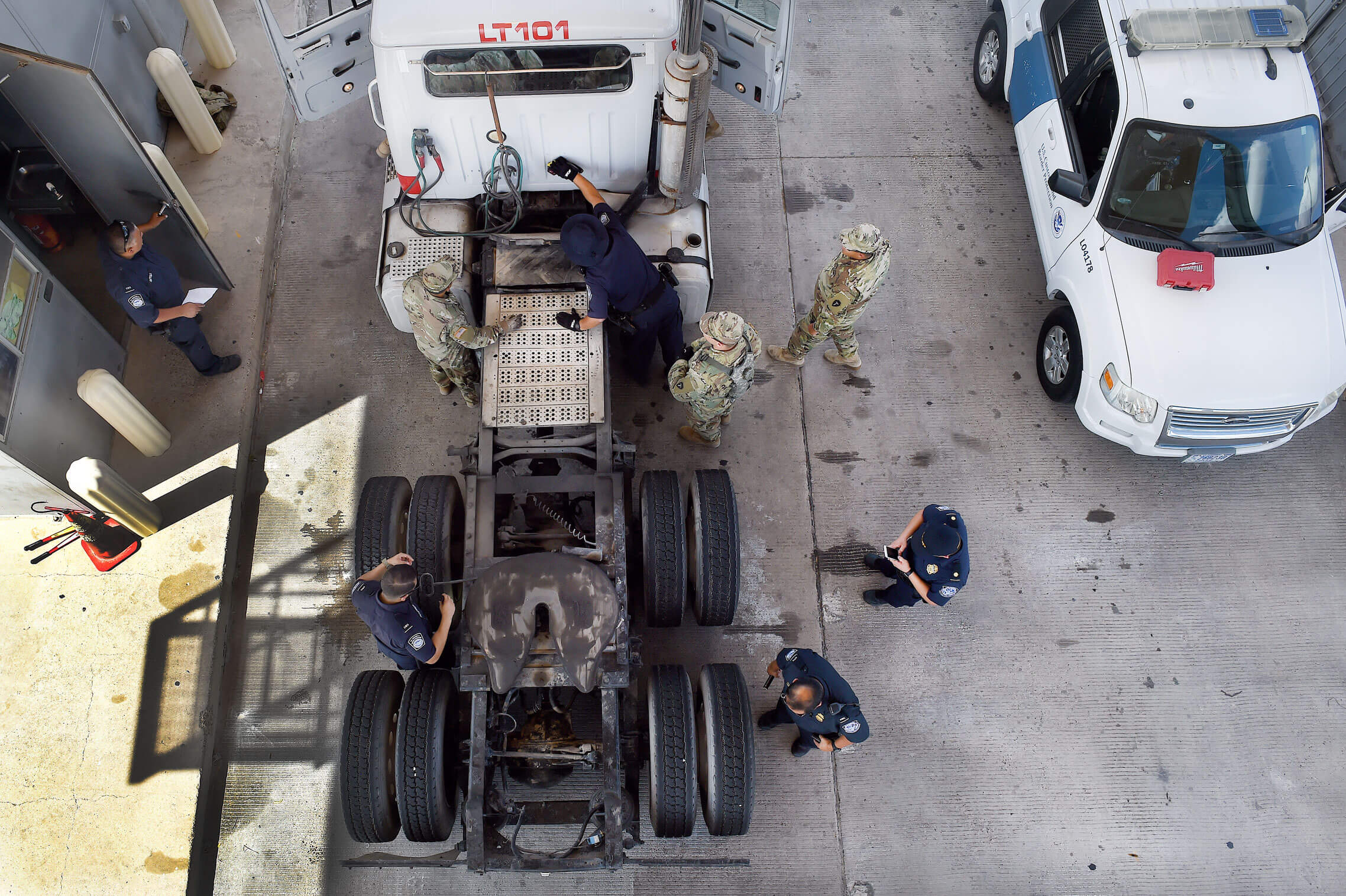 At the U.S. Customs and Border Protection’s Pharr, Texas, port of entry no part of the truck is overlooked as Soldiers with the Texas Army National Guard’s Company A, 536th Brigade Support Battalion, and CBP officers inspect commercial vehicles transiting from Mexico into the U.S. Approximately 2,000 trucks pass through Pharr each day. Guard members’ efforts have allowed increased capability with inspecting inbound trucks for illegal drugs and other prohibited items. In one incident at Pharr, Guard members found close to 100 pounds of heroin and methamphetamine in one vehicle, one of the largest finds since coming on duty in April.
At the U.S. Customs and Border Protection’s Pharr, Texas, port of entry no part of the truck is overlooked as Soldiers with the Texas Army National Guard’s Company A, 536th Brigade Support Battalion, and CBP officers inspect commercial vehicles transiting from Mexico into the U.S. Approximately 2,000 trucks pass through Pharr each day. Guard members’ efforts have allowed increased capability with inspecting inbound trucks for illegal drugs and other prohibited items. In one incident at Pharr, Guard members found close to 100 pounds of heroin and methamphetamine in one vehicle, one of the largest finds since coming on duty in April.
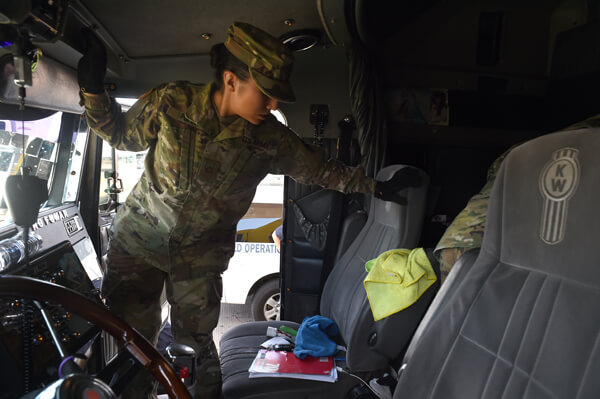 A truck’s interior gets an intensive once over as Army Pfc. Amber Popp, a patient administrative specialist with F Company, 536th BSB, looks for anything out of place that may signal the driver is attempting to carry illegal drugs or other prohibited items into the U.S. through the Pharr port of entry. CBP officers immediately take over if illegal items are discovered, seizing them and detaining the driver.
A truck’s interior gets an intensive once over as Army Pfc. Amber Popp, a patient administrative specialist with F Company, 536th BSB, looks for anything out of place that may signal the driver is attempting to carry illegal drugs or other prohibited items into the U.S. through the Pharr port of entry. CBP officers immediately take over if illegal items are discovered, seizing them and detaining the driver.
The driver of the grey pick-up truck kept moving at a slow, yet uneven pace. A line of cars and trucks continued growing behind him as he made his way down the lane – agonizingly slow, yet still entirely too fast. Spc. Jordan Fons, a light-wheeled vehicle mechanic with the Wisconsin Army National Guard’s 229th Engineer Company, signaled the driver to stop, while glancing at the back-up of vehicles.
To some, it may seem as if Fons had a steadily building traffic problem on his hands. But for Fons, the line of cars was all part of the day ushering drivers through the Nogales, Ariz., port of entry as they crossed the border from Mexico into the U.S.
“I wave a car through at 3 miles per hour,” he said, describing the process.
The speed is crucial. After a primary check from U.S. Customs and Border Protection officers, the drivers are funneled through a large-scale X-ray machine allowing CBP officers to check for illegal items hidden in the vehicle.
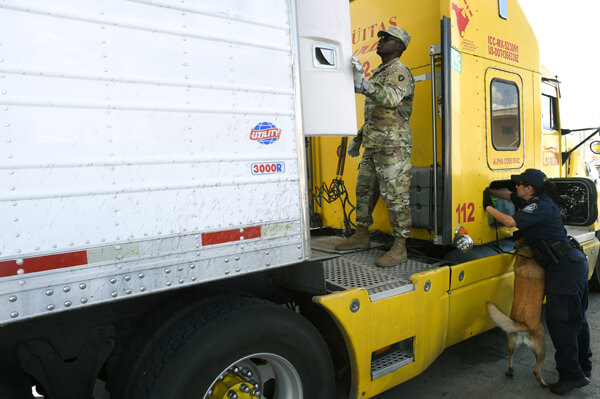 Spc. Isaac Aduhene, a petroleum supply specialist with F Co., 536th BSB, works side-by-side with a CBP officer at the Pharr port of entry.
Spc. Isaac Aduhene, a petroleum supply specialist with F Co., 536th BSB, works side-by-side with a CBP officer at the Pharr port of entry.
That’s where Fons and other Soldiers come in, directing the drivers where to go and ensuring they maintain the proper speed. Too fast – even 5 mph is too fast – and the X-ray scan has to be repeated. Once drivers make it through at a steady 3 mph, they’re asked a few additional questions.
“We ask for the year, make and model of the car and we radio it into [Customs and Border Protection agents],” said Fons, adding that the agents, after reviewing the X-ray scans and other information, determine if the drivers need to move on to a secondary inspection.
“Or, if they’re good to go, we send them on their way,” said Fons.
The traffic through the inspection area ebbs and flows, he said. Sometimes it backs up, while other times it’s free flowing. But, with Fons and other Soldiers directing drivers, CBP agents are freed up for other duties, such as manning additional primary inspection lanes and other law enforcement duties.
While Fons’ duties may focus on passenger vehicles, commercial truck drivers and their vehicles are run through a similar process.
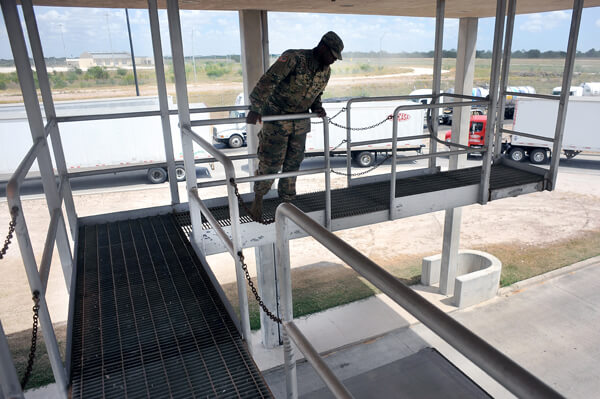 Watching from an overhead catwalk gives Spc. Kendhall Ingram, a truck driver with Headquarters and Headquarters Company, 536th BSB, an overhead view to spot for irregularities on top of trucks and trailers as they are driven into an inspection area below.
Watching from an overhead catwalk gives Spc. Kendhall Ingram, a truck driver with Headquarters and Headquarters Company, 536th BSB, an overhead view to spot for irregularities on top of trucks and trailers as they are driven into an inspection area below.
“We make sure we check all the parts of the trucks for contraband, narcotics and we make sure there is no human trafficking,” said Spc. Afeez Amusan, with the Texas Army National Guard’s Company A, 536th Brigade Support Battalion. “That’s why we’re here.”
Guard members are posted at ports of entry throughout the Southwest border region. Amusan and other members of his unit work at the Pharr, Texas, port of entry, ensuring the roughly 2000 trucks that pass through the port of entry each day do so in an efficient manner. They do that while also keeping an eye out for illegal drugs and other contraband items.
“It’s been going great,” said Army Pfc. Jacob Denby, a medic with C Company, 536th BSB. “It’s been a lot of really good experiences. It’s been a lot of things I’ve never done before.”
The low, rumbling growl of diesel engines is nearly ever present as Denby, Amusan and others from their unit take care of their duties. Semi-trucks sit parked one behind the other, seemingly stretching to the horizon. The engines grumble under the Texas sun in what may appear to some as the world’s largest truck stop parking lot.
Just like passenger vehicles, CBP agents do a preliminary inspection of commercial trucks while also checking the driver’s paperwork. After the preliminary inspection and paperwork review, the drivers are directed to a number of different follow-on inspection lanes, some of which are manned by Amusan, Denby and other Soldiers working alongside CBP agents.
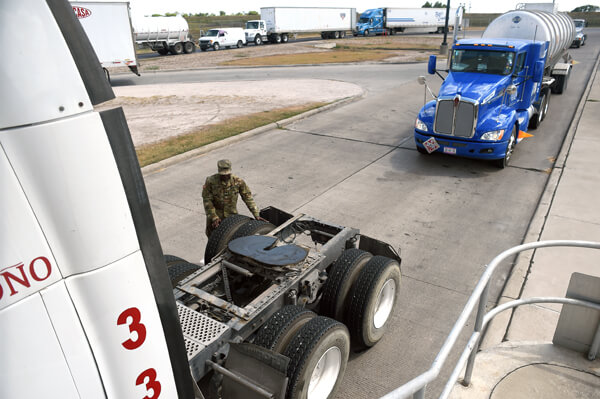 Tires can serve as hiding spot for illegal drugs and other items. To ensure nothing is hidden inside, Spc. Afeez Amusan, a truck driver with Co. A, 536th BSB, taps the tires of a semi-truck at the Pharr port of entry checking for anything out of the ordinary.
Tires can serve as hiding spot for illegal drugs and other items. To ensure nothing is hidden inside, Spc. Afeez Amusan, a truck driver with Co. A, 536th BSB, taps the tires of a semi-truck at the Pharr port of entry checking for anything out of the ordinary.
The Soldiers signal the next driver in the queue to pull into the inspection area. Some trucks are road worn and plain, while others exude chrome-plated flash and metallic sparkle. All receive the same once over from the Soldiers and the CBP officers they work with.
The driver’s paperwork is double-checked as the Soldiers go over the truck, working as a team to examine everything from the engine compartment to the tires on the trailer. Storage compartments are opened, fuel tanks are checked and the interior of the cab is looked over.
Most trucks and drivers clear the inspection and are soon on their way. Some drivers, however, are carrying more than what their cargo manifest lists. Denby saw that firsthand when he found more than 50 pounds of methamphetamine mixed with fentanyl and more than 40 pounds of heroin hidden in fire extinguishers in a truck.
“It was exhilarating,” said Denby, of the find. “It was truly assisting [CBP agents] with finding illegal drugs.”
It also represented one of the largest finds since Denby and his unit came on duty, said officials.
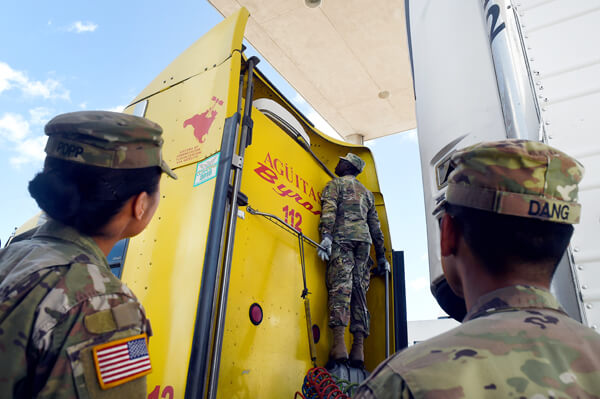 Checking certain areas may mean stretching to the fullest height possible as Aduhene, center, inspects a semi-truck while Popp, left, and Army Cpl. Paul Dang, a combat medic with C Company, 536th BSB, look on from the ground at the Pharr port of entry.
Checking certain areas may mean stretching to the fullest height possible as Aduhene, center, inspects a semi-truck while Popp, left, and Army Cpl. Paul Dang, a combat medic with C Company, 536th BSB, look on from the ground at the Pharr port of entry.
“Drugs fuel crime,” said Denby. “So that’s a lot of meth and heroin that are never going to be on the streets.”
Coming across it, however, was a result of calm observation, he said.
“He was looking shady,” Denby said, of the driver, adding it was mostly a gut feeling that told him something was up. “His truck was dirty and we were like this guy doesn’t seem to be up to par.”
Denby and his team inspected the truck and trailer, and found the drugs in the cab.
“Inside the cab he had too many jugs and fire extinguishers,” Denby said. “We tested them and it was drugs.”
Though Denby and other Soldiers inspect incoming trucks, CBP agents take over if anything suspicious is found. That ensures the evidentiary chain of custody remains intact, said officials.
For Denby, working along the border is a first.
“This is my first, real mission,” he said. “I’ve never been deployed before, never gotten to do a flood mission. This came up and I was more than willing to come out here.”
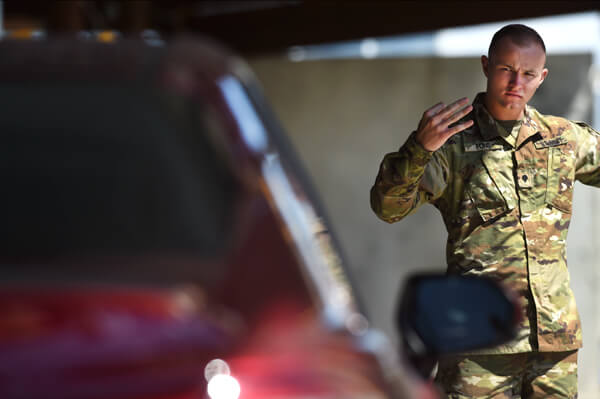 Passenger vehicles get a similar going over as commercial trucks. Spc. Jordan Fons, a mechanic with the Wisconsin Army National Guard’s 229th Engineer Company, directs a driver to pull forward in an inspection lane at CBP's Nogales, Ariz., port of entry. After an initial screening by CBP officers, drivers’ vehicles are X-rayed. Fons directs drivers through the X-ray lanes, sending them on to a secondary inspection area if needed.
Passenger vehicles get a similar going over as commercial trucks. Spc. Jordan Fons, a mechanic with the Wisconsin Army National Guard’s 229th Engineer Company, directs a driver to pull forward in an inspection lane at CBP's Nogales, Ariz., port of entry. After an initial screening by CBP officers, drivers’ vehicles are X-rayed. Fons directs drivers through the X-ray lanes, sending them on to a secondary inspection area if needed.
The experience has broadened his horizons, he said.
“I didn’t really know what was going on down here,” Denby said of issues facing border communities as well as the CBP role. “It’s been a learning opportunity to find there are separate missions [CBP performs]. It’s eye opening. You really see everything that’s going on.”
Back in Arizona, the driver of the grey pick-up has maintained a steady 3 mph and made it through the inspection process. Fons is onto the next car, signaling the driver to pull forward. The speed indicator next to the lane flashes 4 and then 5 mph as the driver moves ahead.
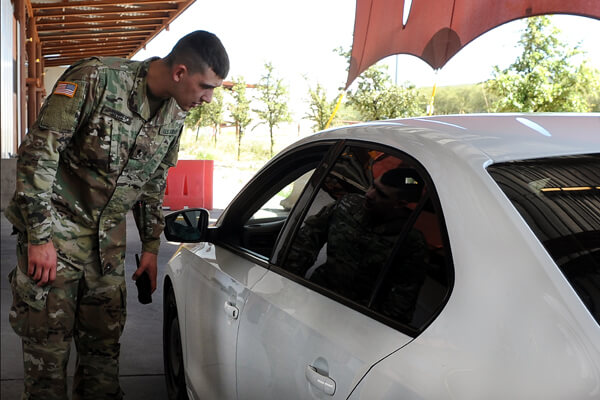 Spc. Nathaniel Snyder, a horizontal construction engineer with the 229th Eng. Co., talks with a driver in the secondary screening lanes at the Nogales port of entry. For many from Snyder’s unit, growing their Spanish language skills has been one of their biggest challenges working along the border.
Spc. Nathaniel Snyder, a horizontal construction engineer with the 229th Eng. Co., talks with a driver in the secondary screening lanes at the Nogales port of entry. For many from Snyder’s unit, growing their Spanish language skills has been one of their biggest challenges working along the border.
“They’ll probably have to back up and go through again,” he says while holding up three fingers to the driver and pointing to the speed limit sign.
The other Soldier working the lane with him agreed.
“It’s tough holding 3 miles per hour,” he said.